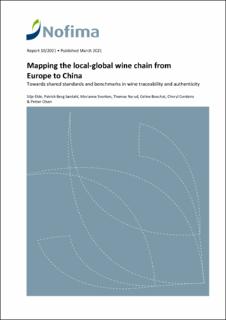Mapping the local-global wine chain from Europe to China : Towards shared standards and benchmarks in wine traceability and authenticity
| dc.contributor.author | Elde, Silje | |
| dc.contributor.author | Sørdahl, Patrick Berg | |
| dc.contributor.author | Svorken, Marianne | |
| dc.contributor.author | Nyrud, Thomas | |
| dc.contributor.author | Boechat, Celine | |
| dc.contributor.author | Cordeiro, Cheryl Marie | |
| dc.contributor.author | Olsen, Petter | |
| dc.date.accessioned | 2021-03-22T08:50:57Z | |
| dc.date.available | 2021-03-22T08:50:57Z | |
| dc.date.created | 2021-03-16T12:59:01Z | |
| dc.date.issued | 2021 | |
| dc.identifier.isbn | 978-82-8296-674-0 | |
| dc.identifier.uri | https://hdl.handle.net/11250/2734677 | |
| dc.description.abstract | When investigating food authenticity and potential fraud, there are two main options. One approach is to focus on determining the chemical, physical, or sensory characteristics of the food samples themselves and check if they match the description provided; the other approach is to analyse the supply chain, and try to identify discrepancies in the recorded data. The work outlined in this report employs the latter approach to investigate wine exported from the Bordeaux region in France and imported to China. The mapping and analysis of the supply chain, and the indication of where fraud might happen was partly based on existing scientific literature, reports, and news stories, and partly on a number of interviews conducted with supply chain actors in France and in China. | |
| dc.language.iso | eng | |
| dc.publisher | Nofima AS | |
| dc.relation.ispartof | Nofima rapportserie | |
| dc.relation.ispartofseries | Nofima rapportserie | |
| dc.title | Mapping the local-global wine chain from Europe to China : Towards shared standards and benchmarks in wine traceability and authenticity | |
| dc.type | Research report | |
| dc.description.version | publishedVersion | |
| dc.source.pagenumber | 42 | |
| dc.source.issue | 10/2021 | |
| dc.identifier.cristin | 1898333 | |
| dc.relation.project | EC/H2020/12125 | |
| cristin.ispublished | true | |
| cristin.fulltext | original |
Tilhørende fil(er)
Denne innførselen finnes i følgende samling(er)
-
Nofima rapportserie [1067]
-
Publikasjoner fra CRIStin [2518]
